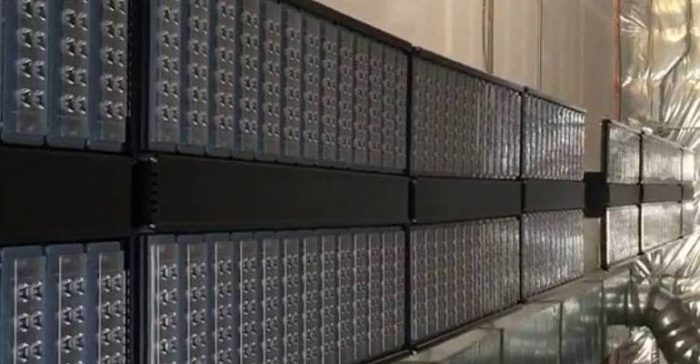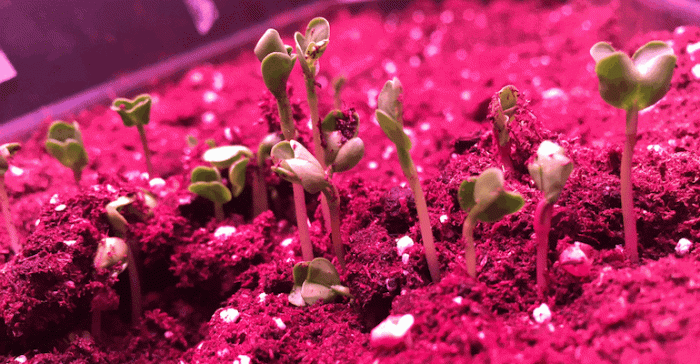Chuck Porter, Jesse Remillard, and Nick Collins, ERS, for Zondits
Zondits recently sat down with Pete Rumsey, Executive Vice President of Sales and Business Development of Lighting Science/VividGro to gain insights into the use of LED grow lighting specifically for the cannabis industry. VividGro, based in West Warwick, Rhode Island, is one of a few leading manufacturers of LED grow lights with more than 10 years of experience in this technology. In the interview, Pete shares the differences between LED and traditional lighting used for growing indoor plants, along with his thoughts on why LED grow lighting is the future of this market.
What is the difference between LED space lighting used for people and LED grow lighting used for plants?
This is a great and important question! A convenient saying to remember here is “Lumens are for humans, and PAR is for plants.” Which is to say, light spectrum matter – the spectrum of light that is optimal for plant growth (e.g., certain red and blue wavelengths of light) – is different from the spectrum of light that is optimal for human vision (e.g., full spectrum light). For conventional LED space lighting, we are typically focused on how many lumens a light source emits as a measure of intensity linked closely to how we humans use light for vision. However, for LED grow lighting, we are not focused on vision but rather photosynthesis. Plants are autotrophs that evolved to use light energy from the sun to create their own food via photosynthesis. Therefore, for LED grow lighting we talk about photosynthetically active radiation (PAR), which is comprised of light between 400–700 nanometers in wavelength. We will typically measure PAR in photosynthetic photon flux (PPF), measured in micromoles of photons emitted per second (micromoles/s). You will also hear us speak of photosynthetic photon flux density (PPFD), which is very useful and measured in micromoles of photons per square meter per second (micromoles/s/m^2) to describe the intensity of light particles (i.e., photons) emitted by an LED light at a specific location on a plant canopy. For LED grow lighting, we therefore focus on achieving the highest PAR output possible combined with high energy efficiency, delivered via a highly effective PAR distribution pattern from the LED luminaires.
At Lighting Science, we have 10+ years of hard-earned experience in LED grow lighting technology, so it does not feel very new to us anymore – although we understand it still does feel new to the growers. What are some of the drawbacks and advantages of using LED grow lighting versus traditional high intensity discharge (HID) lighting?
On the whole, LED grow lighting has surpassed HID lighting in terms of reliability, spectral quality, energy efficiency, and total operating costs. The drawbacks to LED grow lighting versus traditional HID have essentially disappeared at this point in time, with huge technology and quality advances in the last 2–3 years. Unfortunately, it is important to recognize and mention that the first generations of LED grow lighting that started almost 10 years ago left a lot to be desired in terms of cost, quality, and effectiveness, and it gave LEDs a bit of a “black eye.” Also, there are now LED grow fixtures sneaking in and being directly marketed from China that are not reliable, have inadequate light spectral outputs, and have poor quality, design, and engineering, so one must make sure they are buying their LED fixtures from a trusted company. It is worth mentioning for grower safety that working under poorly engineered LEDs that are red-blue spectrum only quickly leads to eye strain and headaches and should be avoided. Also, the flicker in some cheap units is an outright health concern as it can induce seizures in some individuals.
Two drawback items that merit mention are higher immediate upfront costs and a marginally higher 2-D footprint than HPS:
On the upfront cost issue, we are now seeing LED fixtures that are approximately 2x-to-3x the cost for growers of equivalent 1000W HID fixtures; however, with generous utility rebates in many regions the grower may pay about the same price. Also, keep in mind that given the energy efficiency advantage (which we will discuss later), LED grow lights pay for themselves in short order.
On the footprint issue, an HID grow light is quite compact and small; however, LED grow fixtures are now sleek and in many cases smaller as they have become very efficient. HID fixtures are box-like (and will remain that way due to optical requirements and the direct heat emitted by the lamp). LED fixtures, on the other hand, are typically more planar (flat and wide, but not very thick).
The advantages to quality grow LEDs far outweigh the drawbacks now, including the following: 40%+ energy consumption (kWh) reduction, greatly reduced waste heat output (reducing HVAC loads), low-to-no maintenance, available rebates, optimized spectrum and intensity for increased crop quality, reduced grow cycle time, and increased crop yields. Note that the reduced heat output of LED fixtures means they can be also be positioned closer to the canopy and provide higher PAR levels without cooking the plants.
One more critical advantage to Lighting Science grow LEDs is that we have also, as a result of our work with NASA, optimized our LED grow fixtures to be “highly palatable” to human vision for those who must work under and around them. Due to our optimization efforts, we not only improved the horticulture performance, but also created a spectrum that is easy and pleasant to work under and around. HID lighting (and poorly designed LEDs) can be very difficult to work around and cause side effects like eye strain and headaches that impact the performance and health of workers in a grow facility. It is our philosophy that it is very important to have grow lighting that is optimized for both plant growth AND human eyes.

How much energy savings do LED grow lights achieve over HID lights?
We typically see a 40%–45% reduction in energy consumption per light fixture (measured in kWh). LED grow lights also reduce your HVAC load due to reduced heat output per fixture (a 6 kBtu load per 1000 W HID vs. 2.5 kBtu LED – over a 50% reduction).
It is worth mentioning that in several states (Washington, for example) we are seeing growers unable to expand due to both power and HVAC constraints with their local utilities, and LED grow fixtures have saved the day for them. It goes without saying that the long-term sustainable cannabis cultivation will require LED grow lighting—and that is a reason we are so excited about this space. The lower HVAC requirements for LED fixtures also means that a larger percentage of the grow facility can be dedicated to plants, which helps to maximize yield per total facility area.

Are there differences in how you would install and use LED grow lighting versus HID lighting?
There are differences as techniques continue to emerge in the grow community to optimize quality, yields, and crop cycle times. First, we install the LED grow lights closer to the canopy to capture all the PAR – and we can do that without a risk of scorching the plants. Being able to move the light source closer to the plants means we can reach higher PAR levels than HID lighting. This, in turn, means that our customers can push the metabolism and growth rate of the plants very close to their genetic maximums. At Lighting Science, we have experts who will work with our clients to design the optimal layout for each grow room. Also, as we can actually accelerate the growth of plants with the higher PPFD delivered by the LED grow lights (vs. HID), we must take extra care to mind the other limiting variables to photosynthesis to include temperature, humidity, media moisture, CO2 levels, and especially nutrient levels. We have learned that the optimal balance for all these variables can even vary by different strains of cannabis, and we are working closely with many of our growers to grow our knowledge base.
How do LED grow lights perform compared to HID lights in terms of yield and quality of product? Do you have any case studies that demonstrate this?
We can achieve parity with HID results and most often even accelerate photosynthesis (due to high PPFD) with LED grow lighting. Thus, one can achieve equal or usually better potency, yield volume, and/or crop cycle times. As mentioned previously, in addition to the lighting, many factors dictate potential yield volume, quality, and cycle time to include vegetative time, strain choice, grow medium, all the environmental variables (i.e., humidity, temp, moisture, CO2, and nutrients), and grower experience; however, we have repeatedly shown equal or better dry weight yields even exceeding 20%+ gains in some cases. We do have case studies available; however, it is important to note that due to all those variables and factors (independent of lighting choices), we find the best results are achieved by working one-on-one with our grow experts and engineers to optimize each customer’s environment. A one-size-fits-all approach is not advised, and this is well understood in most of the grow community.
With regards to spectrum, we continue to research and refine our ability to soon deliver custom light spectrum “recipes” for particular plant strains.
What are some of the challenges that LED’s face in becoming a mainstream grow lighting choice?
The biggest challenge is the understandable natural aversion to change that we all share, compounded with some unfortunate bad experiences with first-generation LED grow lights from disreputable sources. We at Lighting Science are on our third and fourth generation of LED grow lights, now fortunately with greater benefits than HID.
Also, the reality is that growing is a very complex blend of “science” and some “art“ with many variables, and changing a key component such as lighting is not done lightly. Many, if not most, of the most gifted growers learned their trade and earned their reputation using HID lighting. But with the now clear and compelling advantages of LED grow lighting, especially with regards to energy efficiency and sustainability – not to mention the superior PPFD that LEDs can deliver – it is an opportunity for both seasoned growers to hone their craft as well as for new growers to earn a reputation in the rapidly growing marketplace.
At Lighting Science, we have 10+ years of hard-earned experience in LED grow lighting technology, so it does not feel very new to us anymore – although we understand it still does feel new to the growers. We are now in the mode of small changes to perfect our solutions, and we expect that we will continue to deliver fixtures with high-single-digit improvements in PAR, PPF, and PPFD output and electrical efficiency per watt each year. We are also delivering more modular, scalable and fault-tolerant fixtures with our third generation of our VividGro products now entering the market.
All that said, the two areas of most exciting larger advances in the coming year for us are in the areas of spectrum and cooling:
With regards to spectrum, we continue to research and refine our ability to soon deliver custom light spectrum “recipes” for particular plant strains. This includes customizing the overall PAR spectrum for a particular plant strain and also goes even further to contemplate the ability to dynamically vary the spectrum across the veg to flower stages of growth. We have fully functional prototypes and are in the experimental stages of this technology today so we can have grower-proven light recipes for specific types of plants when they launch.
With regards to cooling, we are also looking at advanced mechanical methods of recapturing the small (compared to HID) but potentially useful waste heat more efficiently. This is in its early stages but very promising in terms of installation simplicity and product cost savings.
